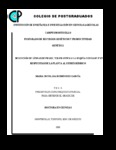Selección de lineas de frijol tolerantes a la sequía con base en respuestas de la planta al estrés hídrico
Abstract
La complejidad de las respuestas de la planta de frijol al estrés hídrico ha dificultado el mejoramiento para tolerancia a sequía, entre otros factores, por la falta de indicadores o criterios fenotípicos confiables, prácticos y repetibles para la selección. La presente investigación se realizó en dos etapas. La primera comprendió la selección en diferentes niveles de estrés hídrico para obtener germoplasma con respuestas diferenciales a la sequía (Capítulo III y IV); y la segunda se proyectó para estudiar las causas de las diferencias en las respuestas a la sequía (Capítulo V). Con tal fin, se utilizó una población segregante de 95 líneas recombinantes F7 derivadas de la generación F3 del cruzamiento AC1028 x Pinto Sierra. Se evaluaron componentes de rendimiento; indicadores fenológicos, morfológicos y de eficiencia fisiológica; e índices relacionados con la tolerancia a la sequía. Para la selección de las líneas se aplicó un modelo que contempló tres aspectos: 1. El rendimiento potencial y adaptación, evaluado en ausencia de estrés hídrico; 2. La estabilidad del rendimiento, evaluada por el índice de susceptibilidad y el porcentaje de reducción, en riego y sequía; y 3. La habilidad de la planta para optimizar su funcionamiento bajo condiciones de estrés hídrico. La población de líneas se avanzó durante cada etapa de selección y sirvió como fuente para identificar al final del proceso12 líneas avanzadas F10, seis tolerantes y seis susceptibles a la sequía (Capítulo III y IV). En las diferentes etapas de selección se observó variación en diferentes características morfológicas, fisiológicas y fenológicas, así como en los componentes de rendimiento y en tolerancia a la sequía. Con base en las evaluaciones del germoplasma en sequía no fue posible atribuir el comportamiento y la respuesta de las líneas a una característica única (Capitulo III, IV y V), por lo que la selección del germoplasma se hizo considerando el mayor número de atributos, la mayoría de ellos complejos, que fueron agrupados usando análisis multivariado. Las características morfológicas, fisiológicas y fenológicas individuales de mayor importancia fueron aglutinadas en dos grupos, uno asociado directamente con los componentes de rendimiento, y otro relacionado con la tolerancia (Capítulo III) y eficiencia fisiológica bajo sequía (Capítulo, IV).___________The complexity of the responses of the dry bean plant to water stress, has made difficult the improvement for drought tolerance. Lack of reliable, practical, and repeatable criteria, such as physiological indexes or phenotypic traits has further complicated this issue. This research was carried out in two steps. The first stage involved the selection under different levels of water stress, for selection of germplasm with differential responses to drought (Chapter III and IV), while the second stage included the study of the causes of the differences in the responses to drought. A segregating population of 95 recombinant lines, derived from the F3 generation of the cross AC1028 x Pinto Sierra was used as testing material. Yield components; phenological, morphological and physiological traits; and indexes associated to drought tolerance were evaluated. For the selection of lines, a model was used involving three aspects: 1. Yield potential and adaptation evaluated under no water stress; 2. Yield stability, assessed by the susceptibility index and percentage of reduction, in irrigation and drought; and 3. The ability of the plant to maximize its performance, under water stress conditions. The population of lines was advanced in each stage of selection and used as source to select 12 advanced F10 lines, six drought tolerant and six susceptible lines (Chapter III y IV). In each stage of selection, variability in morphological, physiological and phenological traits, as well as in yield components and in drought tolerance was observed. Based on the evaluation of the germplasm under drought, it was not possible to assume that the performance as well as the response of the lines to drought were due to a single trait (Chapter III, IV and V), for this reason the selection of lines was carried out considering the largest number of traits, most of them complex, which were clustered by using multivariate analysis. The most important morphological, physiological and phenological traits were clustered into two groups, one associated directly with yield components and other one related with tolerance and physiological efficiency, under drought.
Collections
- Tesis MC, MT, MP y DC [186]

